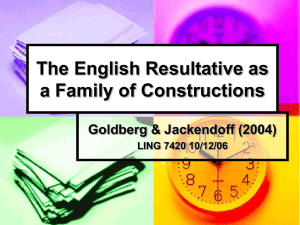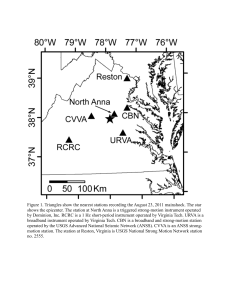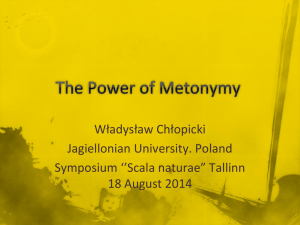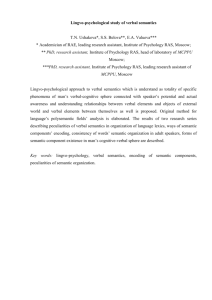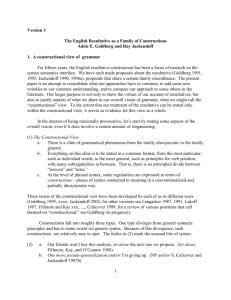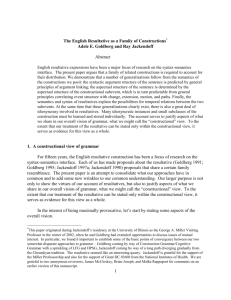Handout for Jill`s presentation
advertisement
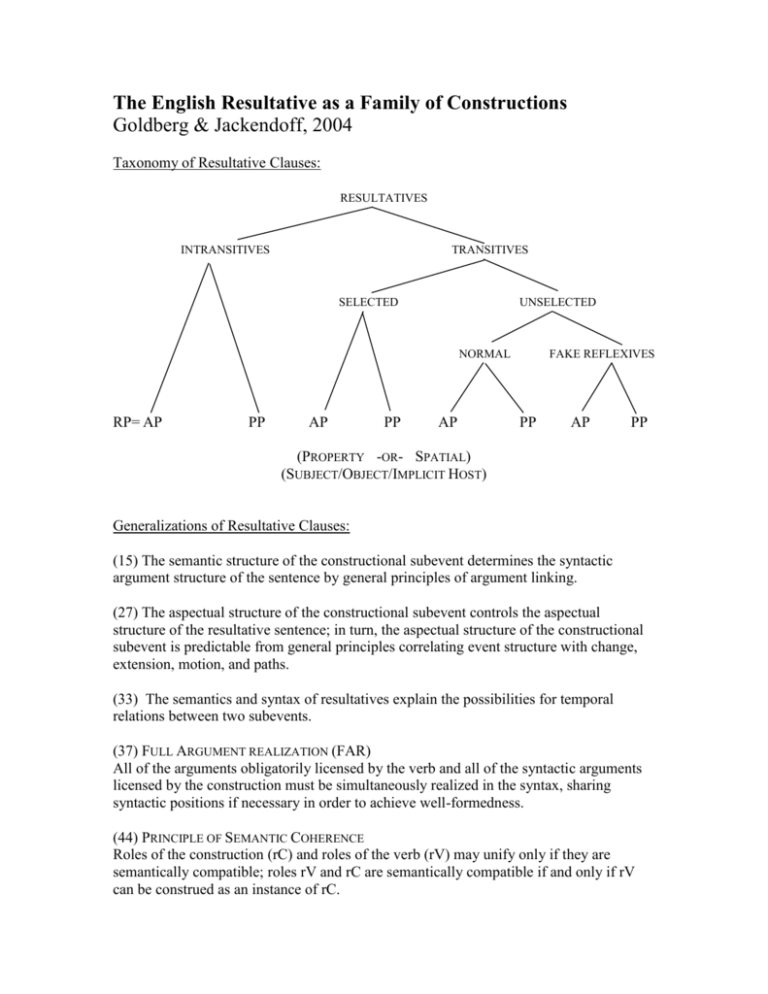
The English Resultative as a Family of Constructions Goldberg & Jackendoff, 2004 Taxonomy of Resultative Clauses: RESULTATIVES INTRANSITIVES TRANSITIVES SELECTED UNSELECTED NORMAL RP= AP PP AP PP AP FAKE REFLEXIVES PP AP PP (PROPERTY -OR- SPATIAL) (SUBJECT/OBJECT/IMPLICIT HOST) Generalizations of Resultative Clauses: (15) The semantic structure of the constructional subevent determines the syntactic argument structure of the sentence by general principles of argument linking. (27) The aspectual structure of the constructional subevent controls the aspectual structure of the resultative sentence; in turn, the aspectual structure of the constructional subevent is predictable from general principles correlating event structure with change, extension, motion, and paths. (33) The semantics and syntax of resultatives explain the possibilities for temporal relations between two subevents. (37) FULL ARGUMENT REALIZATION (FAR) All of the arguments obligatorily licensed by the verb and all of the syntactic arguments licensed by the construction must be simultaneously realized in the syntax, sharing syntactic positions if necessary in order to achieve well-formedness. (44) PRINCIPLE OF SEMANTIC COHERENCE Roles of the construction (rC) and roles of the verb (rV) may unify only if they are semantically compatible; roles rV and rC are semantically compatible if and only if rV can be construed as an instance of rC. Syntactic and Semantic Structure of Resultative Clauses: (14) Causative property resultative Syntax: NP1 V NP2 AP3 Semantics: X1 CAUSE [Y2 BECOME Z3] MEANS: [VERBAL SUBEVENT] (16) a. Noncausative property resultative Syntax: NP1 V AP/PP2 Semantics: X1 BECOME Y2 MEANS: [VERBAL SUBEVENT] b. Noncausative path resultative (intransitive motion construction) Syntax: NP1 V PP2 Semantics: X1 GO Path2 i. MEANS: [VERBAL SUBEVENT] ii. RESULT: [VERBAL SUBEVENT: X1 EMIT SOUND] iii. RESULT: [VERBAL SUBEVENT: X1 DISAPPEAR] c. Causative path resultative (caused motion construction) Syntax: NP1 V NP2 PP3 Semantics: X1 CAUSE [Y2 GO Path3] MEANS: [VERBAL SUBEVENT] Follow verbs (2 possible accounts): (52) Transitive noncausative resultative construction Syntax: NP1 V NP2 PP3 Semantics: X1 GO Path3 MEANS: [VERBAL SUBEVENT: X1 GO [PATH DETERMINED BY Y2] ] -orSyntax: Semantics: NP1 V NP2 PP3 X1 GO-AFTER Y2 Path3 INSTANCE: [VERBAL SUBEVENT] Syntax: Semantics: NP1 V NP2 PP3 X1 GO-BY WAY OF Y2 Path3 INSTANCE: [VERBAL SUBEVENT] MEANS: [VERBAL SUBEVENT] The family of resultative clauses Except for (20) (sound emission and disappearance), the verbal subevent is a means to achieving the constructional subevent. CAUSATIVE AND ARGS IN PARALLEL POSITIONS CHANGE IN PROPERTY 14 16a 16c MOTION IN SPACE 16b 20 52
